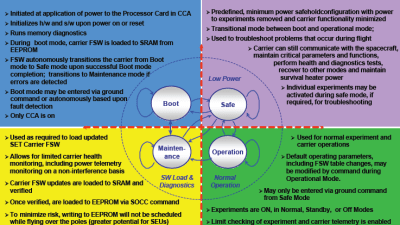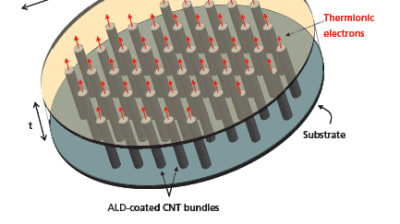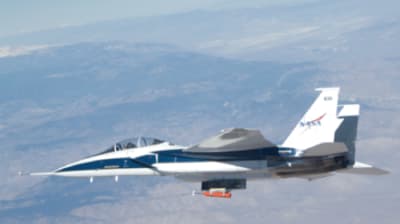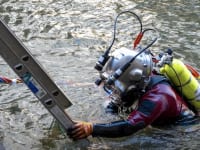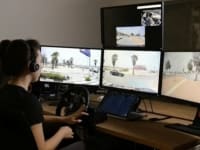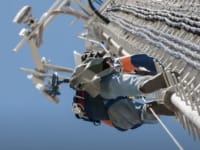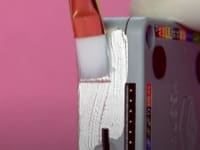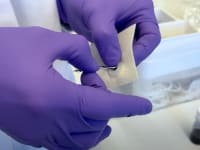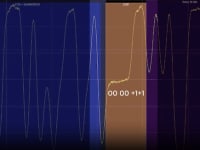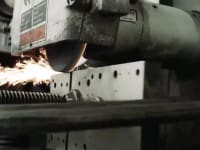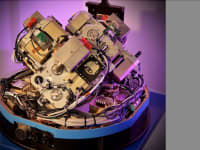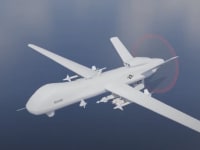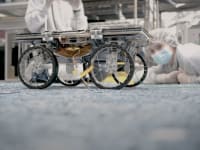61
169
-1
5970
30
Briefs: Electronics & Computers
NEXUS Scalable and Distributed Next-Generation Avionics Bus for Space Missions
A paper discusses NEXUS, a common, next-generation avionics interconnect that is transparently compatible with wired, fiber-optic, and RF physical layers; provides a flexible, scalable, packet switched topology; is fault-tolerant with submicrosecond detection/recovery...
Briefs: Software
The Space Environments Testbed (SET) is a flight controller data system for the Common Carrier Assembly. The SET-1 flight software provides the command, telemetry, and experiment control to ground operators for the...
Briefs: Software
Ndarts
Ndarts software provides algorithms for computing quantities associated with the dynamics of articulated, rigid-link, multibody systems. It is designed as a general- purpose dynamics library that can be used for the modeling of robotic platforms, space vehicles, molecular dynamics, and other such applications. The architecture and algorithms...
Briefs: Software
High-Performance 3D Articulated Robot Display
In the domain of telerobotic operations, the primary challenge facing the operator is to understand the state of the robotic platform. One key aspect of understanding the state is to visualize the physical location and configuration of the platform. As there is a wide variety of mobile robots, the...
Briefs: Software
'In Situ' Surface Characterization
Operation of in situ space assets, such as rovers and landers, requires operators to acquire a thorough understanding of the environment surrounding the spacecraft. The following programs help with that understanding by providing higherlevel information characterizing the surface, which is not immediately obvious...
Briefs: Software
Athena
The Athena simulation software supports an analyst from DoD or other federal agency in making stability and reconstruction projections for operational analyses in areas like Iraq or Afghanistan. It encompasses the use of all elements of national power: diplomatic, information, military, and economic (DIME), and anticipates their effects on...
Briefs: Manufacturing & Prototyping
Cryo-Etched Black Silicon for Use as Optical Black
Stray light reflected from the surface of imaging spectrometer components — in particular, the spectrometer slit — degrade the image quality. A technique has been developed for rapid, uniform, and cost-effective black silicon formation based on inductively coupled plasma (ICP) etching at...
Briefs: Manufacturing & Prototyping
Correcting Thermal Deformations in an Active Composite Reflector
Large, high-precision composite reflectors for future space missions are costly to manufacture, and heavy. An active composite reflector capable of adjusting shape in situ to maintain required tolerances can be lighter and cheaper to manufacture.
Briefs: Manufacturing & Prototyping
Advanced CO₂ Removal and Reduction System
An advanced system for removing CO2 and H2O from cabin air, reducing the CO2, and returning the resulting O2 to the air is less massive than is a prior system that includes two assemblies — one for removal and one for reduction. Also, in this system, unlike in the prior system, there is no need to...
Briefs: Mechanical & Fluid Systems
The landing scheme for NASA’s next-generation Mars rover will encompass a novel landing technique (see figure). The rover will be lowered from a rocket-powered descent stage and then placed onto the surface while...
Briefs: Mechanical & Fluid Systems
Graph Theory Roots of Spatial Operators for Kinematics and Dynamics
Spatial operators have been used to analyze the dynamics of robotic multibody systems and to develop novel computational dynamics algorithms. Mass matrix factorization, inversion, diagonalization, and linearization are among several new insights obtained using such operators. While...
Briefs: Mechanical & Fluid Systems
Spacesuit Soft Upper Torso Sizing Systems
The passive sizing system consists of a series of low-profile pulleys attached to the front and back of the shoulder bearings on a spacesuit soft upper torso (SUT), textile cord or stainless steel cable, and a modified commercial ratchet mechanism. The cord/cable is routed through the pulleys and attached...
Briefs: Mechanical & Fluid Systems
Space Mirror Alignment System
An optical alignment mirror mechanism (AMM) has been developed with angular positioning accuracy of ±0.2 arcsec. This requires the mirror’s linear positioning actuators to have positioning resolutions of ±112 nm to enable the mirror to meet the angular tip/tilt accuracy requirement. Demonstrated capabilities are...
Briefs: Mechanical & Fluid Systems
A unit thermionic power cell (TPC) concept has been developed that converts natural heat found in high-temperature environments (460 to 700 ºC) into electrical power...
Briefs: Medical
Radiation Protection Using Single-Wall Carbon Nanotube Derivatives
This invention is a means of radiation protection, or cellular oxidative stress mitigation, via a sequence of quenching radical species using nano-engineered scaffolds, specifically single-wall carbon nanotubes (SWNTs) and their derivatives. The material can be used as a means of...
Briefs: Medical
PMA-PhyloChip DNA Microarray To Elucidate Viable Microbial Community Structure
Since the Viking missions in the mid- 1970s, traditional culture-based methods have been used for microbial enumeration by various NASA programs. Viable microbes are of particular concern for spacecraft cleanliness, for forward contamination of extraterrestrial bodies...
Briefs: Physical Sciences
This innovation addresses challenges in lidar imaging, particularly with the detection scheme and the shapes of the detected signals. Ideally, the echoed pulse widths should be extremely narrow to resolve fine detail...
Briefs: Physical Sciences
Distributed Capacitive Sensor for Sample Mass Measurement
Previous robotic sample return missions lacked in situ sample verification/quantity measurement instruments. Therefore, the outcome of the mission remained unclear until spacecraft return. In situ sample verification systems such as this Distributed Capacitive (DisC) sensor would enable an...
Briefs: Information Technology
Framework for Integrating Science Data Processing Algorithms Into Process Control Systems
A software framework called PCS Task Wrapper is responsible for standardizing the setup, process initiation, execution, and file management tasks surrounding the execution of science data algorithms, which are referred to by NASA as Product Generation...
Briefs: Information Technology
Base Flow Model Validation
A method was developed of obtaining propulsive base flow data in both hot and cold jet environments, at Mach numbers and altitude of relevance to NASA launcher designs. The base flow data was used to perform computational fluid dynamics (CFD) turbulence model assessments of base flow predictive capabilities in order to...
Briefs: Information Technology
Time Synchronization and Distribution Mechanisms for Space Networks
This work discusses research on the problems of synchronizing and distributing time information between spacecraft based on the Network Time Protocol (NTP), where NTP is a standard time synchronization protocol widely used in the terrestrial network. The Proximity-1 Space Link...
Briefs: Information Technology
Minimum Landing Error Powered- Descent Guidance for Planetary Missions
An algorithm improves the accuracy with which a lander can be delivered to the surface of Mars. The main idea behind this innovation is the use of a “lossless convexification,” which converts an otherwise non-convex constraint related to thruster throttling to a convex...
Briefs: Information Technology
Local Estimators for Spacecraft Formation Flying
A formation estimation architecture for formation flying builds upon the local information exchange among multiple local estimators. Spacecraft formation flying involves the coordination of states among multiple spacecraft through relative sensing, inter-spacecraft communication, and control. Most...
Briefs: Physical Sciences
Reflective Occultation Mask for Evaluation of Occulter Designs for Planet Finding
Advanced formation flying occulter designs utilize a large occulter mask flying in formation with an imaging telescope to block and null starlight to allow imaging of faint planets in exosolar systems. A paper describes the utilization of subscale reflective...
Briefs: Materials
Molecular Adsorber Coating
A document discusses a zeolite-based sprayable molecular adsorber coating that has been developed to alleviate the size and weight issues of current ceramic puck-based technology, while providing a configuration that more projects can use to protect against degradation from outgassed materials within a spacecraft,...
Briefs: Physical Sciences
Software-Defined Radio for Space-to-Space Communications
A paper describes the Space-to-Space Communications System (SSCS) Software-Defined Radio (SDR) research project to determine the most appropriate method for creating flexible and reconfigurable radios to implement wireless communications channels for space vehicles so that fewer radios are...
Briefs: Physical Sciences
The results are described of the Rake Airflow Gage Experiment (RAGE), which was designed and fabricated to support the flight test of a new supersonic inlet design using...
Briefs: Software
Telemetry and Science Data Software System
The Telemetry and Science Data Software System (TSDSS) was designed to validate the operational health of a spacecraft, ease test verification, assist in debugging system anomalies, and provide trending data and advanced science analysis. In doing so, the system parses, processes, and organizes raw data...
Briefs: Electronics & Computers
Experiment in Onboard Synthetic Aperture Radar Data Processing
Single event upsets (SEUs) are a threat to any computing system running on hardware that has not been physically radiation hardened. In addition to mandating the use of performance- limited, hardened heritage equipment, prior techniques for dealing with the SEU problem often involved...
Top Stories
Blog: Manufacturing & Prototyping
2025 Holiday Gift Guide for Engineers: Tech, Tools, and Gadgets
INSIDER: Research Lab
Scientists Create Superconducting Semiconductor Material
Blog: Software
Quiz: Materials
Blog: Aerospace
Tech Briefs Wrapped 2025: Top 10 Technology Stories
Blog: Manufacturing & Prototyping
Webcasts
 Upcoming Webinars: AR/AI
Upcoming Webinars: AR/AI
The Real Impact of AR and AI in the Industrial Equipment Industry
 Upcoming Webinars: Motion Control
Upcoming Webinars: Motion Control
Next-Generation Linear and Rotary Stages: When Ultra Precision...
 Upcoming Webinars: Energy
Upcoming Webinars: Energy
Hydrogen Engines Are Heating Up for Heavy Duty
 Podcasts: Medical
Podcasts: Medical
How Wearables Are Enhancing Smart Drug Delivery
 Podcasts: Power
Podcasts: Power
SAE Automotive Podcast: Solid-State Batteries


